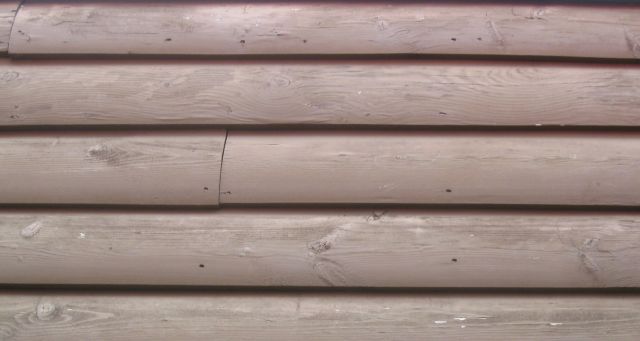The house on the property has D log wood siding. The “D” describes the shape of the log as seen in cross-section, one side is flat and the other has the shape of a D. The house was built in 2002 and when I purchased it 10 years later the siding was neglected. I engaged a well recommended painting contractor who provided a 5 year guarantee. He recommended, rather than a transparent varnish which would show the wood grain underneath, that we use a block stain which required less annual maintenance. The first day they pressure washed the exterior with a bleach solution – actually sprayed is more accurate since the black mold and loose paint was not disturbed. I took photos showing black mold remaining on the surface and contacted the manager and questioned whether it made sense to paint on top of black mold. With much patience he assured me they were professionals, they had “killed” the mold and it was a good base on which to paint, they knew what they were doing and all would be fine. Each subsequent year paint peeled off and the only comfort was they came back each year and after the obligatory pressure wash/spray ($250) did some scraping and repainted. Aggrievedly they told me they were losing money on each visit. I had little patience. I pointed them to the barn which I had pressure washed and scrubbed before painting and which for 5 years had retained a pristine appearance. They provided imaginative explanations which held them blameless as to why the barn looked good and the house did not. Then the 5 year guarantee ran out and I was on my own.
I try to be self sufficient but scraping and painting from a ladder 3+ stories high does not appeal. And M. provides frequent horror stories from hospital roundings of guys my age who fell off ladders and are now done.
So what to do? I should mention that after the third year, peeling paint was a problem only on the sides facing the summer afternoon sun (west and north). The first two years it was a problem most everywhere because they had not properly prepared the surface before painting. But once they had scraped the loose paint and repainted, it was the sides facing the afternoon sun that deteriorated.
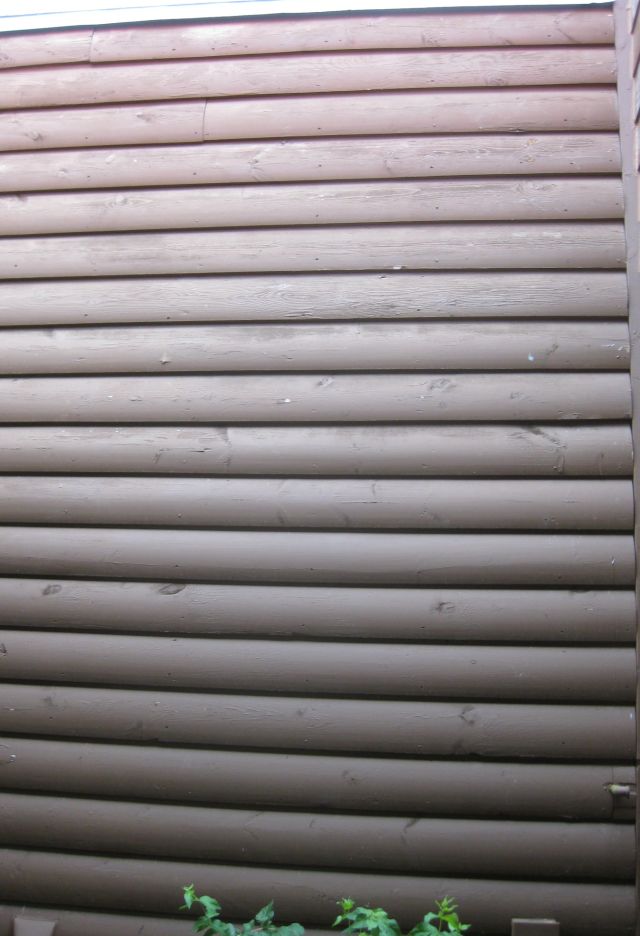
I remembered in New York I had a similar problem and solved it by applying oil based primer as the foundation on the wood surface and then regular latex paint. Perhaps this would also work in the South?
But who would do a thorough paint job for me? I contacted a local contractor but he didn’t impress and the quoted price for just the chimney and a small area was ridiculous. I spoke to a guy who looked like a painter (skinny, the previous guy was overweight) and he was motivated but did not have insurance. Does my house insurance cover a painter fall? The answer from the broker was confused. I decided if any painting was to be done, the painter had to have adequate insurance. I had my neighbor over who builds log homes and he said wood siding needs annual maintenance and I should go with HardiePlank type siding (allura fiber cement siding) which he could install.
the vexing blunder
I mulled this over and suggested we leave the D log siding on the lower 2 levels and just do the 3rd level and gables in fiber cement siding. My thought was I could easily maintain the lower 2 levels. He said this would look silly and M. agreed with him, so I gave the go ahead. We agreed on 3 phases – the chimney first, then the long north side and finally the east/west sides. Most of the siding on the south side is covered by roof overhang and is easily accessible and in good condition.
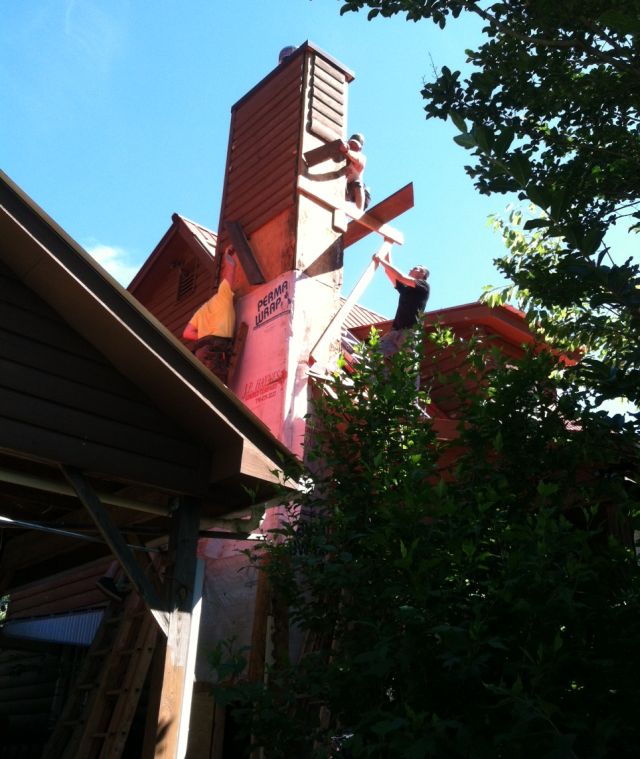
Then came the long side of the house which was also competently done.
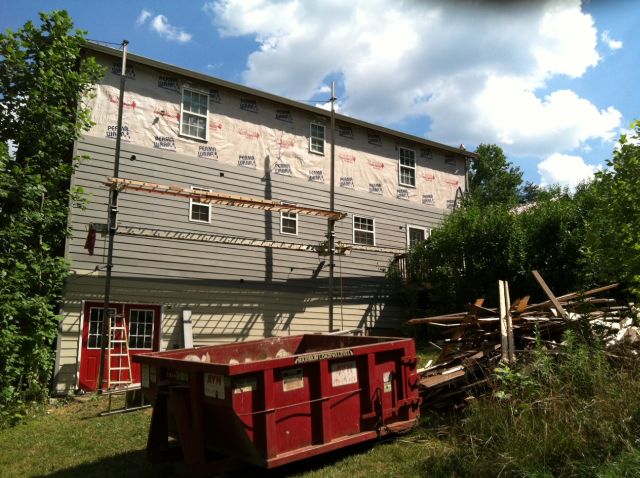
Weather was in the 90’s and after the north side was done I made an upsetting discovery – the a/c took longer to cool down the house. I went outside and leaned a 5 ft fiber cement siding and a 5ft D log board against the north side of the house facing the sun. Then placed my hand on the sun facing sides – both very hot, then the shadowed sides – the cement board was hot, the D log board only warmish. So the wood board had greater thermal mass and that’s why the house had always been so well insulated in the summer and the winter. I felt sick, my first priority has always been to conserve – energy or rainwater, and now I had unwittingly removed good insulation. I delayed the next phase and pondered what to do. Eventually I decided to have fiber cement board on just the 3rd level and gables of the east and west sides, and leave the wood in place on basement and ground level. And the contractor suggested it would help some if I caulked all the windows and doors which abutted the fiber cement siding (apparently it is accepted practice not to caulk these areas).
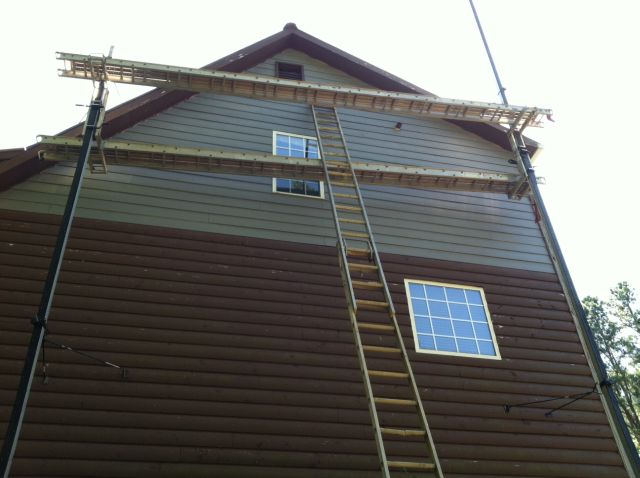
Since the scaffolding would be lowered after the fiber cement siding was installed I suggested extra payment if they would sand and paint the peeling areas. The contractor agreed.
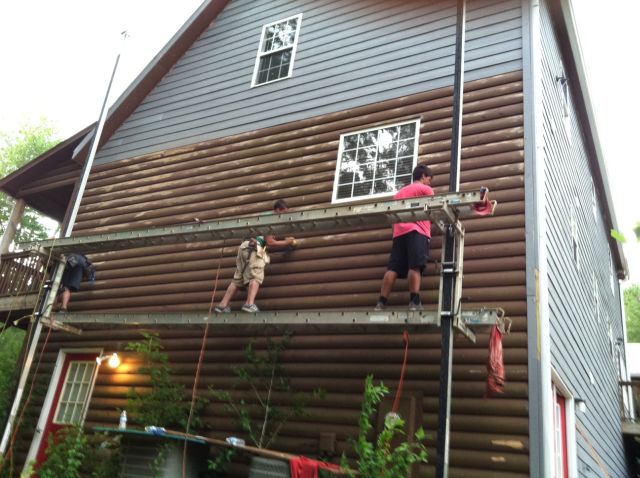
Worth mentioning – yes I got proof of adequate insurance coverage, the flashing was also replaced with fiber cement boards and I pre-painted all the siding before it was installed. Finally on the west side I sanded to bare wood all the boards exposed to the setting sun using a 5″Makita disc sander 4,500rpm with #50 and #80 7″ abrasive discs, which produced some circular scarring. I then painted with oil based primer, then latex primer, then 2 coats of acrylic flat paint. Time will tell if this treatment holds up to the fierce Georgian summer afternoon sun.

